Indexed In
- RefSeek
- Hamdard University
- EBSCO A-Z
- Publons
- Euro Pub
- Google Scholar
- Quality Open Access Market
Useful Links
Share This Page
Journal Flyer

Open Access Journals
- Agri and Aquaculture
- Biochemistry
- Bioinformatics & Systems Biology
- Business & Management
- Chemistry
- Clinical Sciences
- Engineering
- Food & Nutrition
- General Science
- Genetics & Molecular Biology
- Immunology & Microbiology
- Medical Sciences
- Neuroscience & Psychology
- Nursing & Health Care
- Pharmaceutical Sciences
Commentary Article - (2024) Volume 10, Issue 5
Migraines: Causes, Symptoms and Treatment Options
Zeng Jiajun*Received: 26-Aug-2024, Manuscript No. JPMME-24-27470; Editor assigned: 28-Aug-2024, Pre QC No. JPMME-24-27470 (PQ); Reviewed: 11-Sep-2024, QC No. JPMME-24-27470; Revised: 18-Sep-2024, Manuscript No. JPMME-24-27470 (R); Published: 25-Sep-2024, DOI: 10.35248/2684-1320.24.10.295
Description
Migraine is a neurological disorder characterized by severe headaches and a number of symptoms. These headaches can be debilitating and significantly affect a person's quality of life, impacting their ability to perform daily activities and engage in social or work-related activities. While migraines are commonly known for their intense headache, they are a complex condition with a variety of causes, symptoms and treatment options.
It is an ongoing medical condition that causes moderate to severe headaches, frequently accompanied by nausea, vomiting and sensitivity to movement, sound and in some cases, sense of smell. Migraines can last anywhere from a few hours to several days and they can occur anywhere from a few times a month to once in a while. It is estimated that 12% of the population globally suffers from migraines, with women being more probable to experience them than men. Although migraines are generally diagnosed in childhood or early adulthood, they can affect people at any age.
Classification of migraines
Migraines are classified into numerous categories, each with its own set of characteristics.
Migraine without aura or common migraine: This is the most common type of migraine, characterized by a severe headache with sensory abnormalities. It is typically accompanied by nausea, vomiting and sensitivity to light or sound.
Migraine with aura or classic migraine: This type is characterized by energy fields that appear before the headache begins. The aura symptoms are usually visual but can also include sensory or speech disturbances.
Chronic migraine: Chronic migraines develop when a person experiences headaches on more days per month for at least three months. These headaches can last for hours or days and may become more frequent and severe over time.
Menstrual migraine: These migraines occur in women and are closely associated to hormonal fluctuations, particularly around the menstrual cycle. They are frequently triggered by the drop in estrogen levels just before menstruation begins.
Hemiplegic migraine: A severe form of migraine, hemiplegic migraines cause temporary paralysis or weakness on one side of the body, along with other typical migraine symptoms.
Retinal migraine: A rare condition in which a person experiences visual disturbances or even temporary vision loss in one eye during a migraine.
Causes of migraines
Migraines are caused by abnormal brain activity, which affects nerve signals, neurotransmitters and blood vessels in the brain. While the specific etiology of migraines is undetermined, various variables have been attributed to the development of the disease.
Genetics: Family history is an essential factor in migraines. Study has shown that if a person has a parent who suffers from migraines, they are more probable to develop the condition personally. Specific genes involved in pain processing and inflammation may increase susceptibility to migraines.
Environmental factors: Certain environmental triggers, such as strong smells, bright lights or loud sounds, can bring on a migraine. Weather variations, such as temperature and pressure changes, may also contribute to migraine development.
Hormonal changes: Hormonal fluctuations, particularly in women, can significantly influence the occurrence of migraines. Many women experience migraines related to their menstrual cycle, pregnancy or menopausal. The drop in estrogen levels before and during menstruation is a common trigger for migraines.
Dietary factors: Certain foods and beverages can trigger migraines in vulnerable individuals. Common triggers include chocolate, aged cheeses, alcohol (especially red wine), caffeine and foods containing Monosodium Glutamate (MSG) or nitrates.
Citation: Jiajun Z (2024). Migraines: Causes, Symptoms and Treatment Options. J Pain Manage Med.10:295.
Copyright: © 2024 Jiajun Z. This is an open access article distributed under the terms of the Creative Commons Attribution License, which permits unrestricted use, distribution and reproduction in any medium, provided the original author and source are credited.

